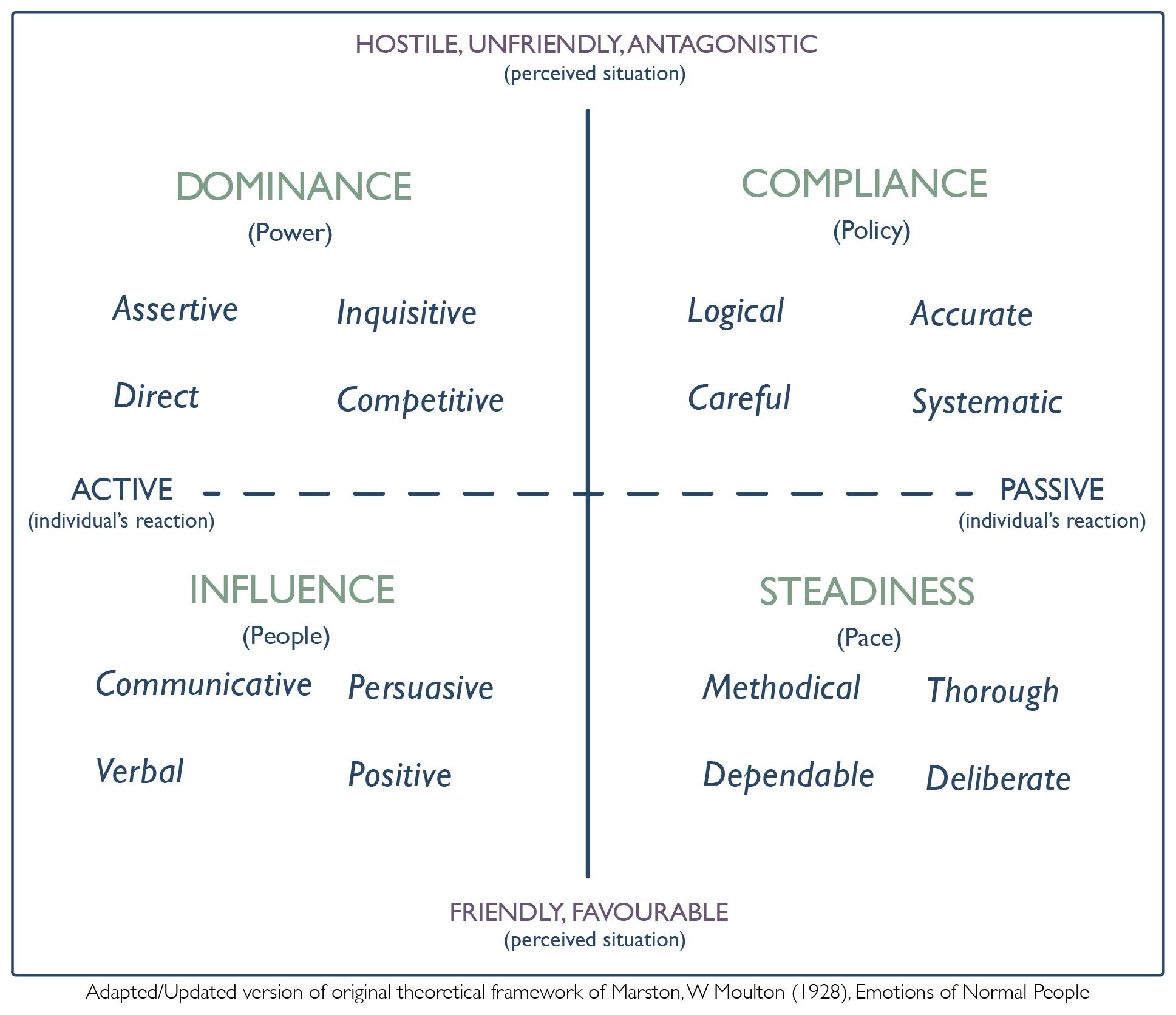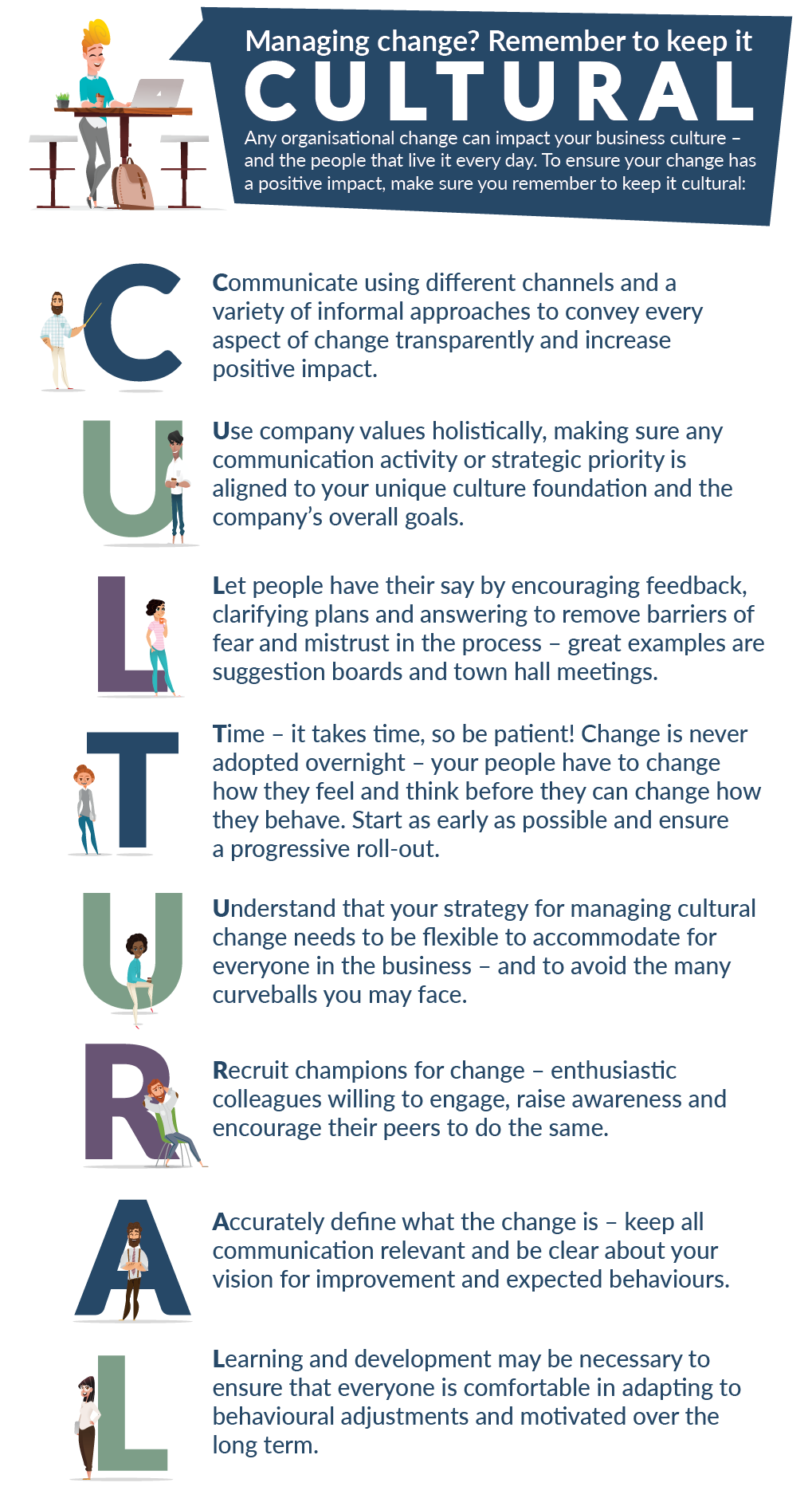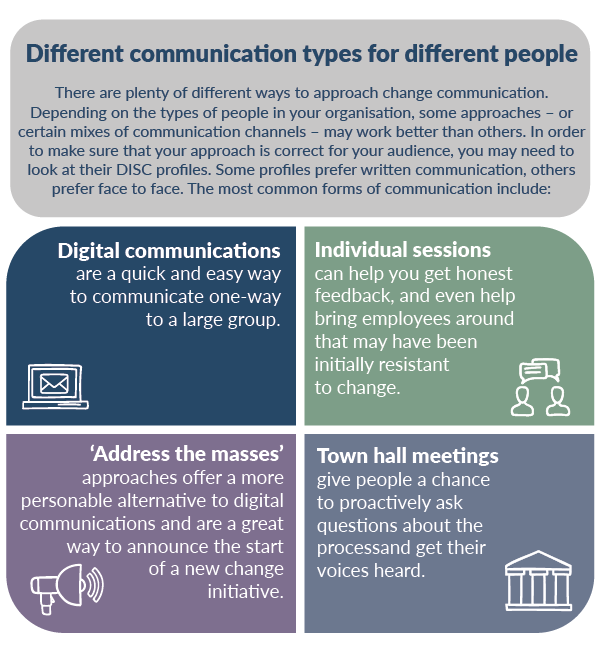Table of contents
A step-by-step change management guide to give you the information you need to execute a successful change process.
Adopting the right approach to change management will mitigate challenges and risk, here's how.
If you rush change and fail to communicate it to your people, it can lead to disruption and reduced morale. But with careful management and transparent communication, you can deliver successful change without the challenge.
At Thomas International, we use psychometric tools and solutions to help organisations like yours get real insights into their employees and how they deal with change. We’ve been doing this since 1981 – and we’ve brought together some of our knowledge to create a set of change management guidelines you can use in your business.
This guide will help you understand the importance of change management, how to get it right and the models you can adopt to see successful change.
What is change management?
Any larger business will experience some kind of change on a daily basis. The form this change takes can range from a slight tweak to a process, to large-scale construction projects, or changes to business models and product designs.
While organisations may make small tweaks constantly, you might be surprised to hear that larger changes happen almost as frequently. According to a Forbes Insights report, 93% of US based companies are in the process of making changes to their business model.
Though they’re incredibly common, many change management projects fail. But the barriers to successful change and the factors causing these projects to fail can be hard to pin down.
But even when the risk is high, organisations will always be rewarded if they can change successfully. That’s because, in a world where opinions, tastes, and trends are constantly shifting, organisations that can rapidly change to keep up will be in the best place to offer maximum value to their customers.
So, organisations need to change because their customers are changing too. But what else is driving this shift, and what’s the best way to go about managing change in your business?

What drives change?
There are a variety of factors that may drive an organisation towards a period of change.
These can come from both internal and external sources, including:
- Customer pressure
- Changes to legislation
- New technology
- Company mergers
- Acquisitions and competition
Whether you face one of these drivers or a mix, you may want to create a change programme to respond. And even if you haven’t seen these drivers yet, proactively changing rather than simply reacting to these trends as they appear can help you get ahead of the curve and set yourself apart from your competitors.
Behind the external drivers
The external drivers are largely economic factors. Business leaders must continually adapt in order to stay ahead of the competition and manage efficient and sustainable growth.
Likewise, the speed of innovation is increasing and the marketplace is ever-evolving, leaving no place for a stagnant enterprise. Change, whether planned or emergent, reactive or proactive, is essential for companies to move their businesses forward.
In a recent Oracle/Forbes Insights survey of 534 global executives, 35% say they believe the need to transform is accelerating. Meanwhile, 82% cite the need for innovation as a major driver of business transformation.
Employees: the drivers and executors of change

Organisational change can also be driven by internal decisions. Whether it’s about improving organisational effectiveness, performance or achieving a new strategic direction or organisational goal, change can be driven by internal pressures and objectives.
Many of these internal drivers are created by employees. But these employees are also critical to delivering the change they create in the first place.
The willingness of employees to adjust their psychology is critical to the successful adoption of change. If employees do not believe that change is needed or that the organisation is capable of change, initiatives are more likely to fail.
Change management models
For over half a century, academics have researched change management theory and the way organisations change. During this time, the research community has developed a range of theoretical change management models that can offer even deeper insights into organisational change.
Lewin’s three-step model
Kurt Lewin (1947) devised a model that sees the change process as involving three steps: unfreezing, movement and refreezing.
Lewin’s model assumes all organisations have a stable position. From there, change is about implementing initiatives that move away from the stable position, shifting the organisation towards the desired behaviours, then securing those behaviours as a new stable position.

This three-step model of change implies that the processes and culture of your organisation will naturally stay at the stable position unless someone in the organisation pushes for change.
Armenakis, Harris and Field (1999) augmented Lewin’s work, adding three measurements to the three-step model:
- Readiness measures how receptive your organisation is to change
- Adoption examines which behaviours are adopted in line with the expectations
- Institutionalisation looks at which changes become fully embedded and emerge as the new norm for your employees
Theory E and O3
Two other theoretical approaches to change are Theory E and Theory O3.
Theory E is driven by economic value. It claims that function and change focus on increasing profitability and market share.
Theory O3 sees change as something driven internally that should concentrate on building organisational capability and fostering a desirable culture.
Planned change models
Planned change models apply themselves to different stages in the lifecycle of an organisation. Incremental models of planned change evaluate external markets with little regard to how to achieve an objective.
The Punctuated Equilibrium Model proposes that organisations enjoy a period of stability that is interspersed with revolutionary periods of change, which give rise to the next period of equilibrium.
The Continuous Transformational Model proposes that the organisation must be continuously planning changes in order to ensure its survival against constantly changing external influences.
The limitations of change models
While planned change models provide a theoretical approach to organisational change, there are limitations to how they can be applied in the real world.
Critics have pointed out how many planned change models are only useful in situations of incremental change on a small scale. Other criticisms focus on the fact that many planned change models assume external environments are stable – rather than the ever-changing backgrounds in which most businesses operate.
These criticisms have led to a growth in support for emergent change management models, which view change as a bottom-up rather than a top-down process. In this respect, change is seen as extremely rapid, leaving little time to put formalised change management steps in place within the organisation to manage it effectively.
These models focus on the process of change, rather than the content that is required for change to take effect. The context and drivers for change must be understood in depth.
No one model fits all
These theoretical models can all be criticised for missing key components of how change really happens in business. However, by understanding a range of models, you can overcome these gaps, and see what components will help you deliver successful organisational change management.
The keys to successful change

Even if you develop the perfect practical change management model, your initiatives could still fail. That’s because many change implementations are at the mercy of the workforce.
Unlike change models, employees are unpredictable. They can impact change success directly by resisting new initiatives. And indirectly, employees could see their performance reduced by change, calling the success of your initiatives into question.
Change for the organisation – and the individual
Individuals hold perceptions and biases that can affect their attitude towards change initiatives within the workplace. If you don’t properly manage those who resist change, it’s likely your initiatives will suffer. That’s why it’s essential to manage change effectively at both the organisational level and an individual level.
Simple considerations can reduce employee resistance to change, but many organisations fail to spend time on these considerations. In fact, 33% of managers completely ignored employees when devising change programmes.
Ignoring your people can have significant impacts on employee behaviour, performance, and even reduced organisational efficiency. However, employees’ expectations and perceptions can be anticipated. And with careful, transparent communication that works around these expectations, you can help your employees have a better, smoother experience with your change management plan.
Ongoing communication between employee and employer is vital so that both parties are aware of the change management frameworks your organisation uses. On-the-job communications such as appraisals help with this immensely.
Change can bring adverse consequences for the employee; including emotional and psychological damage. Stress is common for employees during change implementation, and it almost always has an impact on organisational outcomes. Symptoms can include increased staff turnover and absence, and a marked drop in performance.
However, you can manage the change process to help mitigate stress by ensuring every important stakeholder in the organisation is involved.
Overcoming resistance to change
Imposing change can lead to resistance at any level of the organisation. With this in mind, the entire workforce must feel empowered and involved in the change in order for it to succeed.
You can involve people by using staff surveys, workshops, round table sessions, and nominating change champions within the business. All these activities encourage employees to take an active part in the process – making them far more likely to embrace it.
But it’s crucial that when managing your people in a time of change, you don’t treat them as a single, homogenous group. Each person’s perspective is different, and the same piece of information given to two people can produce two completely different reactions.
Understand employee differences with DISC
A lack of understanding of both ourselves and those around us puts unnecessary barriers on the path to successful change. There is a simple method to understanding how people behave and how they are motivated that can help to break down these barriers.
The DISC model of human behaviour divides employees into different quadrants based on whether they are outgoing or reserved, and if they are more people-oriented or process-oriented.

By using DISC (or another appropriate model for assessing human behaviour), you can identify different behavioural preferences across your teams, and then adapt your change process and communications accordingly.
Recognising our differences and understanding that your people will act and react in unique ways can help you manage, motivate and influence your employees more effectively.
The different stages of employee emotions
Feelings are never static. Employees will move through stages of different emotions and reactions towards change at different rates. To tackle each of the stages, it’s important to constantly monitor how your people are feeling. It also helps to plan for a range of reactions from the very start of your change initiative.
A key part of change is behavioural change. This relies on employees understanding how, why and what they need to change individually in order to play a part in the organisation’s vision.

Kotter & Cohen described the ‘see-feel-change’ steps that an individual must go through in order to adapt changes in their behaviour. An individual has to develop a self-awareness and an understanding of what must be changed.
This deeper level of understanding of their impact evokes emotional responses, which drive changes in beliefs, values, attitudes and behaviour.
It is useful to refer back to the reasons for the change when dealing with resistance from employees. By communicating consistently, frequently and honestly, you can remind employees how well the organisation is doing in achieving its vision – and why that vision is so important in the first place.
Kotter & Schlesinger identified the top reasons for resistance to change:
- Lack of clarity or understanding of the change
- Reluctance to lose something that is perceived to be valuable to the individual
- Limited tolerance or ability to cope with change
- Different understandings of the situation or context
To overcome these reasons for resistance, Kotter and Schlesinger recommends a mix of strategies, including:
- Education and commitment
- Participation and involvement
- Facilitation and support
- Negotiation and agreement
- Manipulation and co-optation
- Explicit and implicit coercion
Help your people weather the change storm

Some change initiatives are successful. Others, less so. Learning from these examples can be useful in designing a programme that empowers and engages employees.
But even if you don’t have the time to dissect each story in detail, there’s a common denominator across all successful change programmes: placing a heavy focus on the employee. The most successful change initiatives view and treat people as the lynchpin of success.
So, what practical steps can you take to make change work with and through your people?
Take stock of your vision
The very first step of a successful change programme involves identifying the need for change. From there, the next step is to clearly articulate this vision.
To do this, you’ll need to conduct a thorough audit across the organisation to determine where you are now, where you want to be, and where the gaps are. This examination should explore both your products and solutions, as well as whether your existing talent can effectively support your goals.
Done well, a benchmarking exercise (sometimes called a Human Capital Audit) will identify whether you already have the capability, profiles and behaviours within the company; whether this existing talent can be developed or re-deployed; and whether you need to fill any gaps with new talent.
This exercise can also help you understand your company’s cultural profile and assess if it is a culture that will help you achieve strategic change.
For many years, the NHS has used this kind of benchmarking to measure best practice and improve hospital trust performance. Having established what ‘good’ looks like, the health service analyses data and weaves the insights into its recruitment and talent management. In doing this, the NHS creates positive change across the workforce.
Ensure transparency
As we have seen, it is crucial that you engage employees from the outset of any change programme. Companies and employees alike cite poor communication as a primary reason for seeing change as difficult or uncertain.
Just as important as communicating the value of change is clearly explaining the impact of not changing. When employees can evaluate both change and stagnation, they can see more clearly that change is a necessity – not just a management whim.
The trick to communicating in a transparent way is to go back to data from your benchmarking exercise. Understanding what type of people you have within your organisation can help you adapt your messaging to suit various personalities and communication styles.
For example, you may have identified a pocket of the organisation that will expect regular updates, want to see evidence that company has truly considered the impact, and need to feel valued by their employer. Meanwhile, another department may not need such frequent updates. You can use this information to structure exactly when you schedule updates across these different groups.

Maintain morale
Possibly the most difficult part of weathering the change management storm is maintaining levels of engagement, commitment and motivation at a time when many will naturally resist or feel insecure about their future with the company.
Beyond a focus on ‘early and often’ communication, the success of your change programme will also depend on how you can keep employees motivated during the change.
During their change period in 2013, Yahoo announced that they had put over 560 initiatives in place that focused on maintaining employee engagement and commitment through morale-boosting policies and processes.
Identifying champions across the business, who represent the full population of the company – from those that are highly engaged to those that are not – can help ensure that all corners of the business are brought along on the journey.
Review, refresh, refocus
Ultimately, all change programmes are designed to future-proof your business. But a single period of change only keeps an organisation ahead of the curve for so long. To ensure the benefits of change continue, it’s important to continually review progress and refocus your vision where necessary.
Refreshing the programme regularly will keep you on track and ensure that your change strategies are being implemented correctly – and having the desired effect.
Again, the data collected during your benchmarking exercise can be useful here. Alternatively, you can use performance data and metrics from ‘launch point’ onwards, and monitor differences or improvements throughout the change period. This will help identify which employees are effectively adopting change, and which need more support.
Hard numbers only go so far
Hard data only tells us so much when trying to understand how successfully you are managing change; anecdotal evidence is also required. Those who are struggling to come to terms with the shift may not voice their concerns or issues openly, so you might assume that your initiatives are working, or be at a loss as to what’s causing friction.
Employee engagement surveys containing a qualitative element will provide that extra layer of information. Done via a confidential, impartial medium, they can even help you to crowd-source ideas from those involved in day-to-day operations.
For example, results may identify specific leaders that are not communicating or implementing the changes as effectively as others. Armed with this information, you can begin offering training or coaching to those individuals or provide other ways to get buy-in from their teams.
Overall, the measure allows you to spot any pain points as they happen, and smooth them out before any more of your workforce becomes disenchanted with the change.
Providing a regular feedback loop – and acting on its output – can only enhance your credibility as leaders of the business. And in some cases, a good feedback loop can provide you with further opportunities to reinforce the original need for change.
Your four-step change management process
The change journey is often a complicated one, and it’s full of moving parts that can be difficult – if not impossible – to manage. But with the right model, you can take a structured change management approach that helps make the journey a little simpler.
At Thomas International we suggest a four-step process to ensure you and your teams can hit the ground running during periods of change.
Step 1: Communicate the change
Effective change starts with effective communication. Make sure change is presented and communicated in a way that appeals equally to a range of different people within the organisation. Get it right and you can help each employee navigate their way through the change process in a way that works best for them.
Step 2: Keep your people engaged
After you’ve announced the plans for change, you need to be conscious of the response from your people. This is where you need to look out for signs of disengagement and take early action to resolve it.

Step 3: Manage and motivate
The next step is about making your people feel valued during change. As you start to come out of the other side of the process, it’s important to maintain employee engagement by encouraging personal development.
By this stage, you know where you are going, and you are aware of any gaps in your process. By really understanding your workforce, you can train people to help fill those gaps.
Step 4: Coach for performance
This final stage is where you begin to see successful implementation of your change taking shape. But this is only the beginning.
This stage is about understanding that continued coaching is essential to maintain high performance and success. After all, one change often quickly leads into another. Only successful coaching will help you make each change smoother and more successful than the last.
Your change management questions answered
At Thomas International we help organisations like yours update and refine their change management processes all the time. We’ve based this section on questions you may be asking right now, and we’ve provided some guidance below.
1. How is change a good thing in the workplace?
Changes in the workplace are not just good for a growing company, but also can be good for the employees as a whole. Changes in an organisation can relate to technology systems and all forms of operational processes and structure. New projects and even positions will become available through organisational change and the most motivated and adaptable employees will have a chance to take on more challenging and satisfying work.
2. Why is it so hard to change in the workplace?
Some people don’t like change. There is often resistance to organisational change. In practice, there are 12 main reasons why people resist change in the workplace:
- Loss of job
- Poor top-down communication
- Fear of the unknown
- Lack of skills for new structure
- Change in routine
- Poor timing
- Lack of reward
- Office politics
- Loss of managers
- Historical change experience
- Peer pressure
- Lack of trust and support
3. What change management strategies should I consider?
Imposing change can lead to resistance at any level of the organisation, therefore the entire workforce must feel empowered and involved in the change in order for it to succeed.
Staff involvement is key for developing a change management strategy – staff surveys, workshops, round table sessions and nominating change champions within the business.
Communication – to gain acceptance and engagement.
Understanding those around you – making sure that you understand who you are communicating to and whether that form of communication is sufficient for them. Someone with a more process based behavioural style may prefer written and detailed information to a conversation skimming over the main ways the change will take place.
4. What are the essentials of change management?
There are several ways that you can ensure that your change initiative is successful:
- Identify what will be improved
- Present a solid business case to stakeholders
- Plan for the change
- Provide resources and use data for evaluation
- Communication
- Monitor and manage resistance
- Celebrate success
- Continuously improve
5. How can I improve my change management processes?
There are several ways to improve your change management process, depending on what you are doing in the first place. The best way to make sure you have a clear process, is to plan thoroughly. Change is essential for businesses to grow, expand and thrive. The plan needs to set out objectives, markets, mission and how these things are about to change.
A change management plan needs to clearly articulate the areas of the business that are to be affected and the impact on customers, suppliers, stakeholders and employees. Finally, and possibly the most important, is to make sure that you communicate. Communication with the entire workforce, not just those who may be affected directly by the change, will make the process easier for you and for your entire company.
6. How do you promote positive change in the workplace?
As with all change in the workplace, the best way to promote positive change is to be honest and open in your communication and to ensure that you communicate that you will ensure the needs of others are considered and respected as you move towards your goal. The second best way to promote positive change in the workplace – is to allow people to have input. Even before you start implementing change, why not run an employee survey and see if what they view needs to be changed aligns with your thoughts.
7. How do you tell employees about change?
There are 5 ways to communicate change for a better employee experience:
- Be clear and honest about what’s changing and why
- Consider the emotional impact of the change
- Tell employees what is in it for them
- Consider the source of communication – depending on the type of behaviours of your staff, it may be better to communicate verbally followed up with an email with more detail about the changes – this way you are appeasing those who prefer to listen and those who need lots of detail and in writing.
- Finally, and the most important, open two-way communication channels. Make sure that the communication works both ways.
8. How do you motivate employees to change?
Set clear expectations and goals – focus less on getting people onboard and more on getting them involved in the change. Make sure you actively listen and engage them for feedback during the change process. You will keep employees motivated as long as you act on the output of the engagement process. If you do not act on their feedback, they will not feel engaged or part of the process.
9. How do you overcome employee resistance to change?
Consistent, frequent, relevant and honest communication and updates about how well the organisation is doing in achieving the vision is essential. Kotter and Schlesinger (2008) have identified several strategies to deal with resistance to change:
- Education and commitment – Educate your staff on the changes, and commit to listening or having an “open-door” policy
- Participation and involvement – encourage your employees to get involved in the process
- Facilitation and support – the opportunity to nominate a change champion who can represent both managers and employees during the change
10. How do I get over my fear of change in the workplace?
There are a variety of reasons that people fear change at work. These include fear of failure, fear of success, fear of looking stupid and fear of the unknown. We’re all creatures of habit and changes at work can move us out of our comfort zone. Depending how we view the change and how it is presented by management, can be more or less stressful and bring up a variety of fears.
The first, most important thing to do in the presence of unsettling changes is to acknowledge it. Recognising and accepting change is the first step towards managing it.
The key to managing all the aspects of change, is to communicate. Communicate your fears, ask questions, make sure you speak out when you are confused by the change and that you have all the information available to you.
Next, know how transitions work and have realistic expectations – we all have the capacity to adjust to change, but that takes time. You will not get over your fear of change just because someone tells you to, it will take time.
Be flexible and get involved – be part of the change. Don’t be rigid and hate change for change’s sake – find out all you can before you pass judgement.
Finally, keep working. Make yourself a value to the company. All change takes time, so the best thing to do is to keep doing what you’re doing.
Conclusion: Change doesn’t have to be challenging
Change is necessary, and nearly every business will experience it. And yet, it remains a source of anxiety for business leaders, their employees, and customers alike.
The key is to ensure employees understand the need for change, what the change will look like, and what the end results may be. When they’re armed with clear information on the change process, they’re more likely to accept change and maintain their motivation. Having a clear roadmap and change structure in place can go a long way to ensuring your employees are on board – and your change takes hold across the business.
You can see how leading global engineering and technology services company, Siemens embedded Thomas assessments in their leadership programme to upskill their HR managers during a global restructure of the organisation.
To see how we can help you further minimise the challenges of change management, or if you have any questions that aren’t covered here, get in touch with one of our experts.




